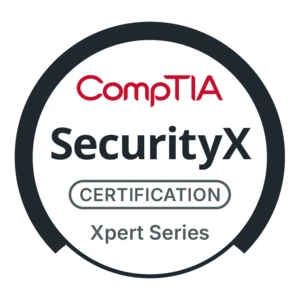Course Overview
SecurityX is an advanced cybersecurity certification for security architects and senior security engineers. It proves you have the skills to design, build, and implement secure solutions across complex environments. You’ll also show you can support a resilient enterprise while addressing governance, risk, and compliance needs.
Skills Learned
- Design, implement, and integrate secure solutions across complex environments to support a resilient enterprise in security architecture and engineering.
- Use automation, monitoring, detection, and incident response to proactively support ongoing security operations.
- Apply security practices to cloud, on-premises, and hybrid environments to ensure enterprise-wide protection.
- Utilize cryptographic technologies and techniques while evaluating the impact of emerging trends, such as artificial intelligence, on information security.
- Implement governance, compliance, risk management, and threat modeling strategies across the enterprise.
- Validate advanced, hands-on skills in security architecture and senior security engineering within live environments.
Exam Details
- Exam version: V5
- Exam series code: CAS-005
- Launch date: December 17, 2024
- Number of questions: maximum of 90, a mix of multiple-choice and performance-based questions
- Retirement: usually three years after launch (estimated 2027)
- Duration: maximum of 165 minutes
- Passing score: pass/fail only; no scaled score
- Languages: English, with other languages to be determined
- Recommended experience: minimum of 10 years of general hands-on IT experience, including 5 years of hands-on security, with Network+, Security+, CySA+, Cloud+, and PenTest+ or equivalent knowledge
- NICE and DoD 8140 work roles: security architect, systems requirements planner, security control assessor, research and development specialist, and more
Career Path
Target Audiance
- IT Professionals who want to develop or strengthen their knowledge of core cybersecurity concepts.
- Aspiring Cybersecurity Specialists seeking an entry point into the security domain.
- Network and System Administrators who manage IT infrastructures and need to understand security best practices.
- Technical Support Staff and Help Desk Technicians aiming to expand their skills into cybersecurity.
- Students and Graduates of IT or computer science programs who want to pursue a cybersecurity career path.
- Business and Technology Professionals who interact with sensitive information systems and require a foundation in security principles.
- Career Changers transitioning into the cybersecurity field and looking for a recognised entry-level certification.




 4.8
4.8